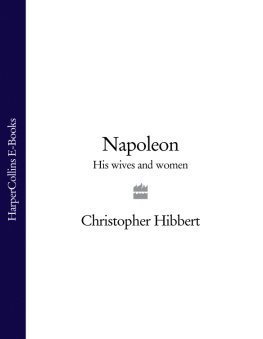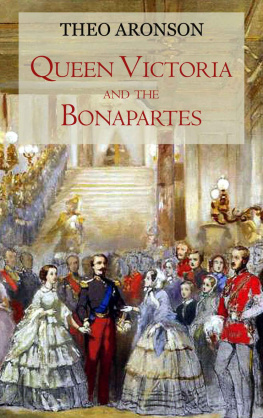Routledge Revivals
THE WOMEN BONAPARTES
THE WOMEN BONAPARTES
THE MOTHER AND THREE SISTERS OF NAPOLEON I.
BY
H. NOEL WILLIAMS
AUTHOR OF FIVE FAIR SISTERS, ETC.
First published in 1908 by Methuen & Co. Ltd.
This edition first published in 2018 by Routledge
2 Park Square, Milton Park, Abingdon, Oxon, OX14 4RN
and by Routledge
711 Third Avenue, New York, NY 10017
Routledge is an imprint of the Taylor & Francis Group, an informa business
1908 Taylor & Francis
All rights reserved. No part of this book may be reprinted or reproduced or utilised in any form or by any electronic, mechanical, or other means, now known or hereafter invented, including photocopying and recording, or in any information storage or retrieval system, without permission in writing from the publishers.
Publishers Note
The publisher has gone to great lengths to ensure the quality of this reprint but points out that some imperfections in the original copies may be apparent.
Disclaimer
The publisher has made every effort to trace copyright holders and welcomes correspondence from those they have been unable to contact.
A Library of Congress record exists under ISBN: 09001981
ISBN 13: 978-1-138-55257-9 (hbk)
ISBN 13: 978-1-138-56706-1 (pbk)
ISBN 13: 978-1-315-12397-4 (ebk)
THE WOMEN BONAPARTES
BY THE SAME AUTHOR
FIVE FAIR SISTERS
A PRINCESS OF INTRIGUE
MADAME RCAMIER AND HER FRIENDS
MADAME DE POMPADOUR
MADAME DE MONTESPAN
MADAME DU BARRY
QUEENS OF THE FRENCH STAGE
LATER QUEENS OF THE FRENCH STAGE
QUEEN MARGOT
CAROLINE BONAPARTE, QUEEN OF NAPLES, AND HER ELDER DAUGHTER, PRINCESSE MARIA LOETITIA JOSPHINE MURAT, AFTERWARDS CONTESSA PEPOLI
FROM THE PAINTING BY MADAME LEBRUN AT VERSAILLES
THE WOMEN BONAPARTES
THE MOTHER AND THREE SISTERS OF NAPOLEON I.
BY
H. NOEL WILLIAMS
AUTHOR OF FIVE FAIR SISTERS, ETC.
WITH THIRTY-SIX ILLUSTRATIONS
VOLUME II
First Published in 1908
CONTENTS
LIST OF ILLUSTRATIONS
CAROLINE BONAPARTE, QUEEN OF NAPLES, and her elder daughter, PRINCESSE MARIE LTITIA JOSPHINE MURAT (afterwards CONTESSA PEPOLI), from the painting by Madame Lebrun at Versailles
(Photograph by Neurdein frres)
, from the statue by Canova, in the Villa Borghese, Rome
(Photograph by Anderson, Rome)
, from the statue by Lorenzo Bartolini, reproduced from M. Paul Marmottans les Arts en Toscane sous Napolon: la Princesse lisa, by permission of the author
, from a lithograph by Delpech
, from an engraving after the painting by Regnault (British Museum)
, reproduced from M. Paul Marmottans les Arts en Toscane sous Napolon: la Princesse lisa, by permission of the author
, from an engraving by Reinaud, after the drawing by Ingres (Bibliothque Nationale)
, from an engraving after the drawing by Pauquet (British Museum)
, from the painting by Grard at Versailles
(Photograph by Neurdein frres)
, after a miniature painted in 1810. Reproduced from M. Paul Marmottans lisa Bonaparte, by permission of M. Honor Champion
, from the painting by Madame Lebrun at Versailles
(Photograph by Neurdein frres)
, from an engraving by Lewis, after the painting by Sir Thomas Lawrence (British Museum)
from the painting by Grard at Versailles
(Photograph specially taken for the book)
, in the midst of her Court, after the painting by Benvenuti, reproduced from M. Paul Marmottans les Arts en Toscane sous Napolon : la Princesse lisa, by permission of the author
, from the painting by Grard at Versailles
(Photograph by Lvy)
, reproduced from Dr. J. Holland Roses The Life of Napoleon I, by permission of Messrs. G. Bell and Sons
, reproduced from his Napoleon at Fontainebleau and Elba, by permission of Mr. John Murray
, from an engraving after the drawing by Flameng (British Museum)
after a drawing made in 1835 by Princesse Charlotte Bonaparte, reproduced from Baron Larreys Madame Mre, by permission of M. Arthme Fayard, Paris
THE
WOMEN BONAPARTES
W E left Pauline setting out with her husband on her journey to Italy. After spending a few days in Florence, at Borgheses palace in the Via Ghibellina, and being entertained, by the widowed Queen of Etruria, to a State dinner at the Palazzo Pitti, on which occasion the comical sight which that ugly, deformed little princess presented in full Court toilette so tickled Pauline that she was quite unable to restrain her merriment, they reached Rome on December 9.
The new princess, as may be supposed, had no reason to complain of the reception which was accorded her, both by the Papal Court and by society. On the day of her arrival, Cardinal Consalvi, the Secretary of State, the Dowager-Princess Borghese, and all her husbands relatives residing in Rome called upon her, and overwhelmed her with compliments and attentions. A few days later, she had an audience of Pius VII, who accorded her the unusual honour of being received in his own apartments, instead of in the gardens of the Vatican, where ladies of high rank were usually presented to him; and Consalvi wrote to the Nuncio in Paris that his Holiness had been pleased with her beyond all conception, and the princess equally so with the Pope, and that the latter had made her a present of a magnificent chaplet and a superb cameo. The next few days were devoted to receiving, at the Palazzo Borghese, the Roman nobility, the members of the Sacred College, and the Diplomatic Corps, and a round of sumptuous dinners and magnificent ftes completed the princesss introduction to her new life.
Pauline certainly seems to have made a wonderfully favourable impression upon Roman society, and Consalvis despatches to Caprara are full of the most glowing accounts of her physical and moral perfections, the charm which she exercised over every one, from the Holy Father downwards, the great and edifying familiarity in which she lived with her mother-in-law and the Borghese, and the tender affection which reigned between her and her husband, all of which was, needless to say, duly brought by the astute Nuncio to the notice of the Emperor, and occasioned him such gratification that, on January 17, 1804, he wrote to accredit his sister officially to the Pope, which, owing to his anger at her mariage de conscience, he had hitherto refused to do.
But, unhappily, Napoleons hopes that his volatile sister would be contented with her new life, and would continue to deserve the encomiums which were lavished upon her, were doomed to disappointment. For a few weeksthat is to say, until the novelty of her surroundings had begun to wear offPauline was enchanted with Rome. She was gratified by the universal homage which was paid her, the murmurs of admiration which greeted her whenever she appeared in public, the splendid entertainments which were given in her honour. She was pleased with the sumptuously-furnished apartments set apart for her use in that splendid palace with its cloistered courtyard and its Renaissance garden; and, although she knew and she is said to have remarked on being introduced to Agasiass










